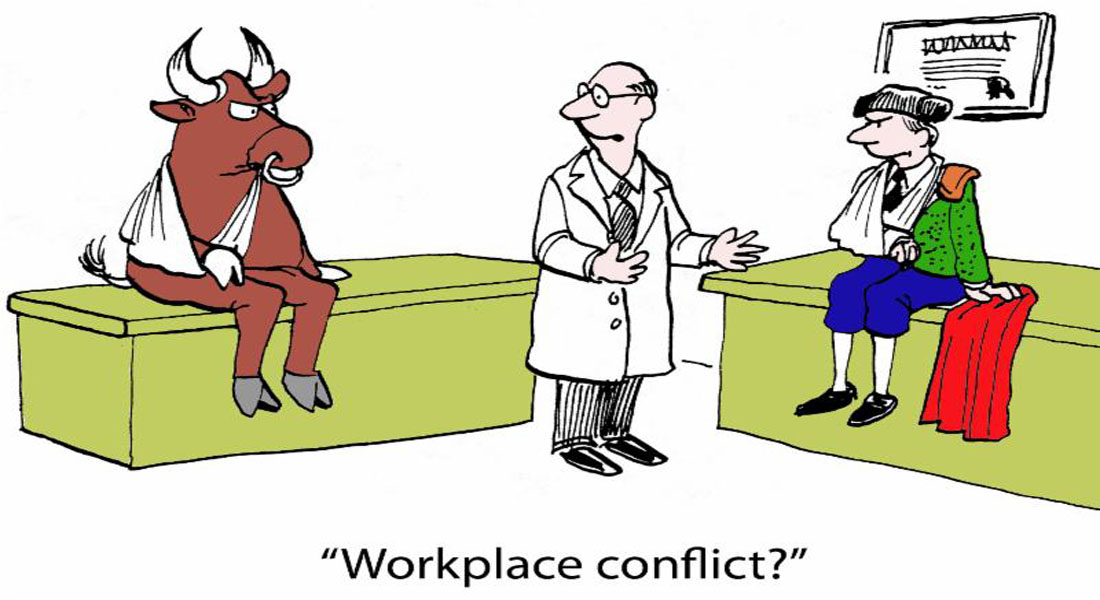Did you know the typical manager spends 25-40% of their time dealing with workplace conflict? That’s up to two days a week of manager’s time, according to a Washington Business Journal report.
When this insidious productivity killer runs amok, its sneaky, underlying destructiveness can be as carefully hidden as “Game of Thrones” backroom machinations. Typically, by the time workplace conflict is observed and addressed, too late – if it’s ever addressed at all.
Conflict is not always bad; sometimes it’s even necessary. How do you know how seriously workplace conflict negatively impacts your organization?
Workplace Conflict Out Of Control? 8 Telltale Signs
As a manager, if your gut is telling you something is not quite right… listen!
Ranging from apparently benign to glaringly obvious, here are eight telltale signs it’s time to take action:
| Silence | Absenteeism |
| Team breakdowns | Missed deadlines |
| Bad decisions | Grievances |
| Quality issues | Turnover |
Fortunately, conflict management is a skill that can be learned, and implemented. Here’s a few pointers to get you started….
7 Tips for Healthy Workplace Conflict Management
1. Walk softly, but carry a big stick.
Even back in the first century A.D., Cicero’s contemporary Publilius Syrus wryly noted “It is folly to punish your neighbor by fire when you live next door.”
Handle conflicts privately and confidentially, unless the offense is so egregious and public it requires an equally public rebuttal to confront hostile work environment behavior. Even then, this approach should only be delivered by a manager skilled enough and high enough in the hierarchy. Unless a scorched earth policy is required, build in an opportunity for the offender(s) to apologize and redeem themselves. Even superstars aren’t perfect, but they still need to learn it’s not ok to run roughshod because consistently good results require an integrated team effort. When there are no losers, everyone wins.
2. Suss out the conflict’s origin, scope and players.
Consider whether the change is a systemic (such as when two departments are fighting for the same resources, or resort to finger-pointing when failures happen) or a personal issue (for example, problems exacerbated by a style clash, or pettiness that gets in the way of adequately addressing performance issues).
- If the conflict is systemic, identify who is impacted and who at least needs to be considered if not consulted. Make sure those who are tapped are empowered to make change or provide recommendations that will be respected and considered, and get feedback on the next steps. Keep in mind systemic issues are tougher nuts to crack; they usually took a while to develop and a clear path forward make take some time.
- If the issue is personal, involve only those who are clearly and specifically part of the problem. Anyone else impacted should be approached or informed only if needed.
3. Figure out the rules of the game.
Take care that all involved in the resolution have equal say and are heard, in describing their version of what caused the conflict, how it impacted them, and most important of all, clearly identifying all issues, and putting them in writing. Ground rules may be needed up front regarding how this can happen (ex. up front agreement regarding confidentiality, respectful sharing and listening).
4. Begin with the end result in mind.
- Focus on the task and how it impacts the business, not the person.
- Focus on the constructive criticism, specifically exemplifying what positive values actions, and behaviors you do want. Cite what has not happened as needed in as factual, non-inflammatory terms as possible.
5. Get the resolution process right.
- Once the issues are identified, those involved can begin to move toward making constructive suggestions toward resolution, noting who will do what, when.
- The end agreed upon result is ideally written, signed and dated.
- If those involved cannot do this themselves, bring in someone neutral to manage the process.
6. Bring in the big guns.
- Decide if you need to bring in professional assistance, such as a professional mediator for intervention and ideally, conflict management policy review, training and coaching. Need help justifying the expense? Try running a conflict calculator to get a better sense of what a particular conflict costs your organization.
7. The worst you can do is… nothing.
Ignoring conflicts that continue to escalate with no sense its underlying causes will improve is often more destructive than confronting it. It sends an unintentional message of condoning the destructive issue or behavior. Martin Luther King Jr. warned, “Our lives begin to end the day we become silent about things that matter.”
Nancy Glock Grueneich advises, “Treat diversity as a source of knowledge — and use conflict as a source of creative energy, not as a reason to quit.” With strategy, skill, courage and perseverance, conflict management not only possible, it’s a winning asset.
Are You Afraid to Deal with Workplace Conflict?
Connie Dorigan, Founder and Director of Recruiting, sees the food processing industry as the link between good living and good people. She’s the west coast’s most experienced and trusted food processing recruiter. She also provides Executive and Career Coaching and lots of free job search tools. Once you’ve connected with Connie, you’ll always be connected.
© 2018 Connie Dorigan. All rights reserved.
This is a general interest article and does not constitute specific or legal advice.





